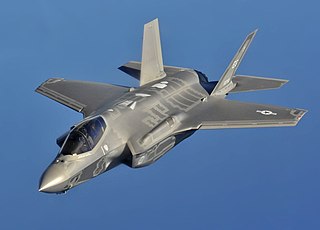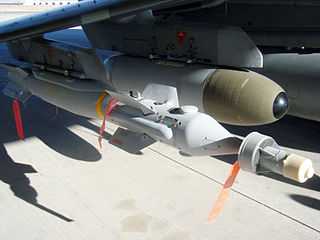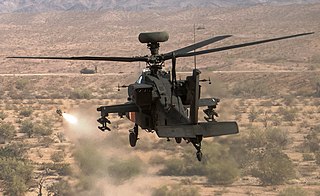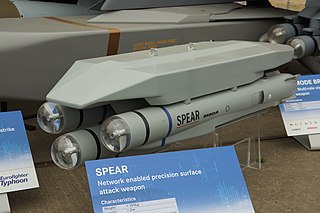
The Lockheed AC-130 gunship is a heavily armed, long-endurance, ground-attack variant of the C-130 Hercules transport, fixed-wing aircraft. It carries a wide array of ground attack weapons that are integrated with sophisticated sensors, navigation, and fire-control systems. Unlike other modern military fixed-wing aircraft, the AC-130 relies on visual targeting. Because its large profile and low operating altitudes of approximately 7,000 feet make it an easy target, its close air support missions are usually flown at night.

The Lockheed Martin F-35 Lightning II is an American family of single-seat, single-engine, all-weather stealth multirole combat aircraft. It is intended to perform both air superiority and strike missions while also providing electronic warfare and intelligence, surveillance, and reconnaissance capabilities. Lockheed Martin is the prime F-35 contractor, with principal partners Northrop Grumman and BAE Systems. The aircraft has three main variants: the conventional takeoff and landing F-35A (CTOL), the short take-off and vertical-landing F-35B (STOVL), and the carrier-based F-35C (CV/CATOBAR).
The GBU-10 Paveway II is an American Paveway-series laser-guided bomb, based on the Mk 84 general-purpose bomb, but with laser seeker and wings for guidance. Introduced into service c. 1976. Used by USAF, US Navy, US Marine Corps, Royal Australian Air Force and various NATO air forces.

Guided Bomb Unit 15 is an unpowered, glide weapon used to destroy high-value enemy targets. It was designed for use with F-15E Strike Eagle, F-111 'Aardvark' and F-4 Phantom II aircraft. The GBU-15 has long-range maritime anti-ship capability with the B-52 Stratofortress. Rockwell International is the prime contractor for this weapon system.
The Joint Direct Attack Munition (JDAM) is a guidance kit that converts unguided bombs, or "dumb bombs", into all-weather precision-guided munitions. JDAM-equipped bombs are guided by an integrated inertial guidance system coupled to a Global Positioning System (GPS) receiver, giving them a published range of up to 15 nautical miles (28 km). JDAM-equipped bombs range from 500 pounds (227 kg) to 2,000 pounds (907 kg). The JDAM's guidance system was jointly developed by the United States Air Force and United States Navy, hence the "joint" in JDAM. When installed on a bomb, the JDAM kit is given a GBU nomenclature, superseding the Mark 80 or BLU nomenclature of the bomb to which it is attached.

The Advanced Short Range Air-to-Air Missile, also known by its United States identifier AIM-132, is an imaging infrared homing air-to-air missile, produced by MBDA, that is designed to fill the within visual range combat mission. It is currently in service in the Royal Air Force (RAF) and Royal Australian Air Force (RAAF), replacing the AIM-9 Sidewinder. ASRAAM is designed to outrange and outrun any other IR missile in service, allowing the pilot to fire and then turn away long before the opposing aircraft can close for a shot. It flies at well over Mach 3 to ranges as great as 50 kilometres (31 mi), considerably over double the range of earlier designs. It retains a 50 g manoeuvrability provided by body lift technology coupled with tail control.

Paveway is a series of laser-guided bombs (LGBs).

Storm Shadow is an Anglo-French low-observable air-launched cruise missile, developed since 1994 by Matra and British Aerospace, and now manufactured by MBDA. Storm Shadow is the British name for the weapon; in French service it is called SCALP EG. The missile is based on the earlier MBDA Apache anti-runway missile, and differs in that it carries a warhead rather than submunitions.

The McDonnell DouglasF-15E Strike Eagle is an American all-weather multirole strike fighter derived from the McDonnell Douglas F-15 Eagle. The F-15E was designed in the 1980s for long-range, high-speed interdiction without relying on escort or electronic-warfare aircraft. United States Air Force (USAF) F-15E Strike Eagles can be generally distinguished from other U.S. Eagle variants by darker aircraft camouflage, conformal fuel tanks (CFTs) mounted along the engine intake ramps and a tandem-seat cockpit.

Brimstone is an air-launched ground attack missile developed by MBDA for Britain's Royal Air Force. It was originally intended for "fire-and-forget" use against mass formations of enemy armour, using a millimetric wave (mmW) active radar homing seeker to ensure accuracy even against moving targets. Experience in Afghanistan led to the addition of laser guidance in the dual-mode Brimstone missile, allowing a "spotter" to pick out specific and the highest priority targets, particularly useful to minimise collateral damage when friendly forces or civilians were in the area. The tandem shaped charge warhead is much more effective against modern tanks than older similar weapons such as the AGM-65G Maverick, while the small blast area minimises collateral damage. Three Brimstones are carried on a launcher that occupies a single weapon station, allowing a single aircraft to carry many missiles.

Paveway IV is a dual mode GPS/INS and laser-guided bomb manufactured by Raytheon UK. It is the latest iteration of the Paveway series.

An air-to-surface missile (ASM) or air-to-ground missile (AGM) is a missile designed to be launched from military aircraft at targets on land or sea. There are also unpowered guided glide bombs not considered missiles. The two most common propulsion systems for air-to-surface missiles are rocket motors, usually with shorter range, and slower, longer-range jet engines. Some Soviet-designed air-to-surface missiles are powered by ramjets, giving them both long range and high speed.

The "SPICE" is an Israeli-developed, EO/GPS-guided guidance kit for converting air-droppable unguided bombs into precision guided bombs.

A guided bomb is a precision-guided munition designed to achieve a smaller circular error probable (CEP).
The GBU-44/B Viper Strike glide bomb was a GPS-aided laser-guided variant of the Northrop Grumman Brilliant Anti-Tank (BAT) munition which originally had a combination acoustic and infrared homing seeker. The system was initially intended for use from UAVs, and it was also been integrated with the Lockheed AC-130 gunship, giving that aircraft a precision stand-off capability. The Viper Strike design is now owned by MBDA.

The AGM-179 Joint Air-to-Ground Missile (JAGM) is an American military program to develop an air-to-surface missile to replace the current air-launched BGM-71 TOW, AGM-114 Hellfire, and AGM-65 Maverick missiles. The U.S. Army, Navy, and Marine Corps plan to buy thousands of JAGMs.

The AGM-176 Griffin is a lightweight, precision-guided munition developed by Raytheon. It can be launched from the ground or air as a rocket-powered missile or dropped from the air as a guided bomb. It carries a relatively small warhead, and was designed to be a precision low-collateral damage weapon for irregular warfare. It has been used in combat by the United States military during the War in Afghanistan.

A precision-guided munition is a guided munition intended to precisely hit a specific target, to minimize collateral damage and increase lethality against intended targets. During the First Gulf War guided munitions accounted for only 9% of weapons fired, but accounted for 75% of all successful hits. Despite guided weapons generally being used on more difficult targets, they were still 35 times more likely to destroy their targets per weapon dropped.

The GBU-39/B Small Diameter Bomb (SDB) is a 250 lb (110 kg) precision-guided glide bomb that is intended to provide aircraft with the ability to carry a higher number of more accurate bombs. Most US Air Force aircraft will be able to carry a pack of four SDBs in place of a single 2,000 lb (907 kg) bomb.

The Select Precision Effects At Range (SPEAR) Capability 3 is a future British air-to-ground and possibly anti-ship missile.


















